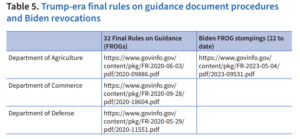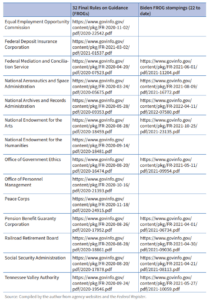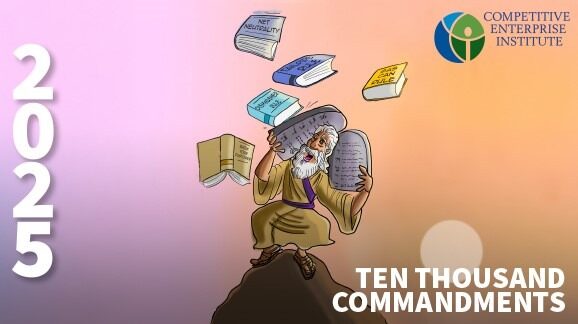Chapter 5: Well over 20,000 agency public notices annually
Presidents issue a few dozen memoranda and other proclamations each year. Departments and agencies issue thousands. These include guidance documents, notices, memoranda, letters, bulletins, action plans, and policy statements. They can use these to signal expectations for, specify parameters for, and influence policy for health care, retirement, education, energy production, finance, land and resource management, science and research, and manufacturing.
Prominent examples in recent years have included post-CARES Act eviction moratorium extensions by both the Trump and the Biden administrations; Biden’s student loan forgiveness and the Department of Education’s changing of eligibility rules on a website; Federal Trade Commission guidance on disclosures for social media influencers and its “Policy Statement Regarding the Scope of Unfair Methods of Competition Under Section 5 of the Federal Trade Commission Act”; and similar “Guidance Regarding Interpretation of Unfair and Deceptive Practices” from the Department of Transportation.
The year 2023 brought a joint Dear Colleague and Q and A from the Departments of Justice and Education addressing college admissions criteria and navigating “lived experience with race” in the wake of the Supreme Court’s decision in Students for Fair Admissions, Inc. v. President and Fellows of Harvard College and Students for Fair Admissions, Inc. v. University of North Carolina et al., in a manner leveraging investigations into universities’ legacy admissions. A Federal Register notice from the Securities and Exchange Commission issued at the behest of the New York Stock Exchange allowed exchange listing of Natural Asset Companies. It was subsequently withdrawn after public outcry.
Some overarching “meta” guidance operates across agency and amplifies Biden’s whole-of-government progressive pursuits. Examples include OMB’s reworking of Circular A-4 and supporting materials to bias cost–benefit analysis, OMB’s proposed guidance on ecosystem services, the joint Federal Trade Commission and Department of Justice Merger Guidelines, emergent artificial intelligence policy, and the social engineering of equity action plans transformed into an annual requirement on the part of federal agencies, since revoked by Trump.
Even though rooted in public laws, new initiatives like federally directed electric vehicle charging networks and drone airspace management will likely be significantly governed by guidance, not proper rulemaking. Written guidance increasingly may not even be necessary. Emergent automobile passive monitoring and disengagement, a central bank digital currency, and government-run payment systems are likely to be administered by less formal means.
Tens of thousands of public notices appear in the Federal Register every year, in addition to annual final and proposed rules. These typically consist of non-rulemaking documents, such as meeting and hearing announcements and agency organizational material. But they can also include memoranda, bulletins, guidance documents, alerts, and other proclamations that may be more consequential to the public like some of the big-ticket items noted previously. Figure 16 depicts notices published annually between 2015 and 2024. Standing at 25,506 in 2024, notices peaked at over 26,000 in 2010 and 2011 (tallies of notices and the related “other” also appear in Appendixes E and M). Although many notices are trivial, there have been 740,069 since 1994 and well over a million since the 1970s.

Finding the substantive guidance amid this haystack remains a challenge. A 2018 House Oversight Committee report titled “Shining Light on Regulatory Dark Matter” found that agencies had issued at least 13,000 guidance documents since 2008, of which at least 536 were significant. Recognizing such concerns, Donald Trump’s 2019’s EO 13891, “Promoting the Rule of Law Through Improved Agency Guidance Documents,” established online inventories at agency websites and required formal rulemakings on public-fairness procedures.
Biden reversed these, so that at this point most of the 32 departments and agencies that adopted formal guidance document public-fairness and transparency procedures wrote new rules to affirmatively disavow and eliminate the nascent disclosures, as shown in Table 5. The haste of repudiation and boilerplate language conforms well with the vision of the Circular A-4 rewrite. Trump will reinstate much of his streamlining apparatus.
Surveying the remnants of the EO 13891 portals, this author’s 2024 compilation of guidance documents topped 108,000 across departments, agencies, subagencies, and commissions. These revelations were possible only because of EO 13891, which points to the power of increasing disclosure and shining more such sunlight across the entire administrative state apparatus.



